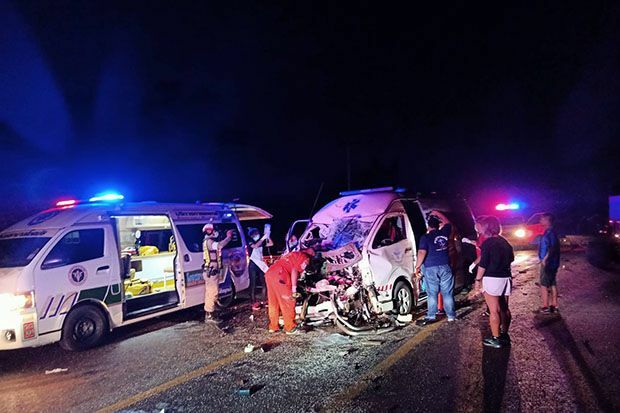Latest ambulance crashes in Thailand dismay researchers
Patient badly injured in nightmare crash

The grim statistics on ambulance crashes in Thailand worsened on Friday night when a patient was badly injured in a horrific late-night crash.
An ambulance smashed into the back of a truck in the Lom Sak district in the northern part of Phetchabun province, northern Thailand, close to midnight on Friday.
The patient, who was being rushed from Khao Kho Hospital in Phetchabun to Lomsak Hospital in the same province was badly injured.
Racing toward Lomsak Hospital, the emergency vehicle suddenly rammed into the rear end of a six-wheel truck at the Nam Chun intersection around 11pm, according to police who were quickly on the scene.
As in so many ambulance crashes in Thailand, a nurse who was accompanying the patient on the journey was also hurt in the accident.
The front end of the ambulance was very badly damaged, and the vehicle will almost certainly be written off.
Medics and rescue workers rushed to the scene to help the injured continue their hazardous trip to Lomsak Hospital.
Police were questioning the drivers of both vehicles to establish the cause of the accident.
Ambulance crashes in Thailand are disturbingly frequent, particularly in rural areas.
Last year, six people, including a patient and two nurses, were badly hurt when a hospital ambulance and a pickup truck crashed at an intersection in Khon Kaen.
Eight people were seriously injured in two crashes at another spot in Phetchabun province a year ago, when a speeding ambulance slammed into a police pickup truck where a little earlier a sedan had crashed into a power pole.
Ambulance crashes delay patient transfer and risk their lives, those of ambulance crews, and other road users. In low- and middle-income countries, where motor vehicle crash rates are typically high, ambulances have a very high risk of being involved in a crash.
Systematic measures to change protocols or even legislation, as well as data collection, are required to address the issues.
Safety issues that need to be addressed include speed limits, safety devices, seatbelt use, securing equipment, and vehicle safety standards. The prospects for immediate improvement in the situation are bleak.
Latest Thailand News
Follow The Thaiger on Google News:



























